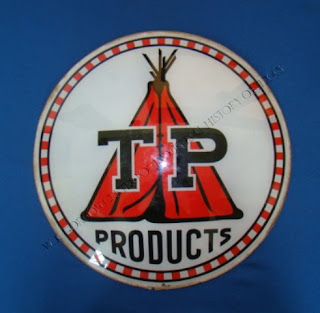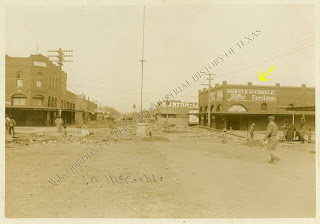Fill Your Tank with TP Gasoline!
In 1928 the Texas Pacific Coal and Oil Company opened its first TP Aero Brand filling station in present day downtown Fort Worth, Texas in the middle of the wide intersection at West Seventh Street and Camp Bowie Boulevard. It was designed in a unique octagonal shape and constructed of brick and ceramic tile. As time went by, the city reworked the hectic crossing and the station was destroyed. Between 1928 and 1938 the company had service stations in approximately eighty five towns across West Texas and the Panhandle. Eventually, Texas and Pacific supplied over five hundred service stations in Texas and Oklahoma.
 The first Texas Pacific Coal and Oil Company filling station at West Seventh Street and Camp Bowie Boulevard in Fort Worth, Texas. Reproduced from a Texas Pacific highway map courtesy Pete Charlton.
The first Texas Pacific Coal and Oil Company filling station at West Seventh Street and Camp Bowie Boulevard in Fort Worth, Texas. Reproduced from a Texas Pacific highway map courtesy Pete Charlton.
As automobiles gained popularity, owners required fuel to be accessible at more regular intervals. Early on, blacksmith shops, hardware stores, and grocery stores first provided the necessary local access to fuel supplies. Because moving and storing the gasoline was dangerous, however, these locations began delivering fuel by barrel to the consumer’s home. Ultimately, filling stations built specifically for the purpose created a safe and convenient outlet for the consumer.
 TP gasoline and motor oil ink blotter featuring the Teepee advertising theme.
TP gasoline and motor oil ink blotter featuring the Teepee advertising theme.
In 1929, the W.P. Boyd service station opened in Thurber, Texas, the birthplace of Texas Pacific Coal and Oil. The brick and tile building featured a herringbone pattern driveway, and is noted for its beautiful detail. The company installed four pumps at the Thurber location. To place the station in the middle of town square, workers moved the band stand to the south end of the square.
 J. R. Foster grocery and feed store in Lake Worth, Texas, which proudly sold TP products.
J. R. Foster grocery and feed store in Lake Worth, Texas, which proudly sold TP products.
In order to maintain and restock individual service stations, many owners purchased supplies from bulk stations. Located near refineries operated by Texas Pacific, bulk outlets provided product and equipment such as signage, storage tanks, pump globes, and push pumps to service stations in the surrounding area. Storage tanks at the stations were generally placed underground and contained the station’s fuel. Globes were placed on top of the pump to advertise the brand and display the TP logo. Push pumps moved the gas from the underground tank into a cylinder at the top of the fuel dispenser where it was measured. Afterward, it flowed by gravity into the customer’s gas container or automobile tank. Not only did these bulk stations deliver to the company-owned outlets and individually-owned stations, they also distributed gasoline and oil to many of the company departments and subsidiaries and other businesses including dairies, parks, ranches, and farms.
 Original lens from a TP pump globe.
Original lens from a TP pump globe.
These service stations helped transform the Texas Pacific Coal and Oil Company into one of the most profitable businesses throughout Texas. With the significant number of service stations in the state, it helped smooth over the transformation for Texans coming into the automobile age.

